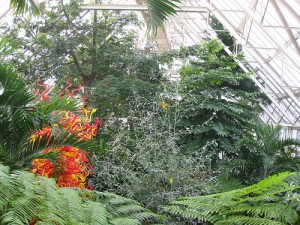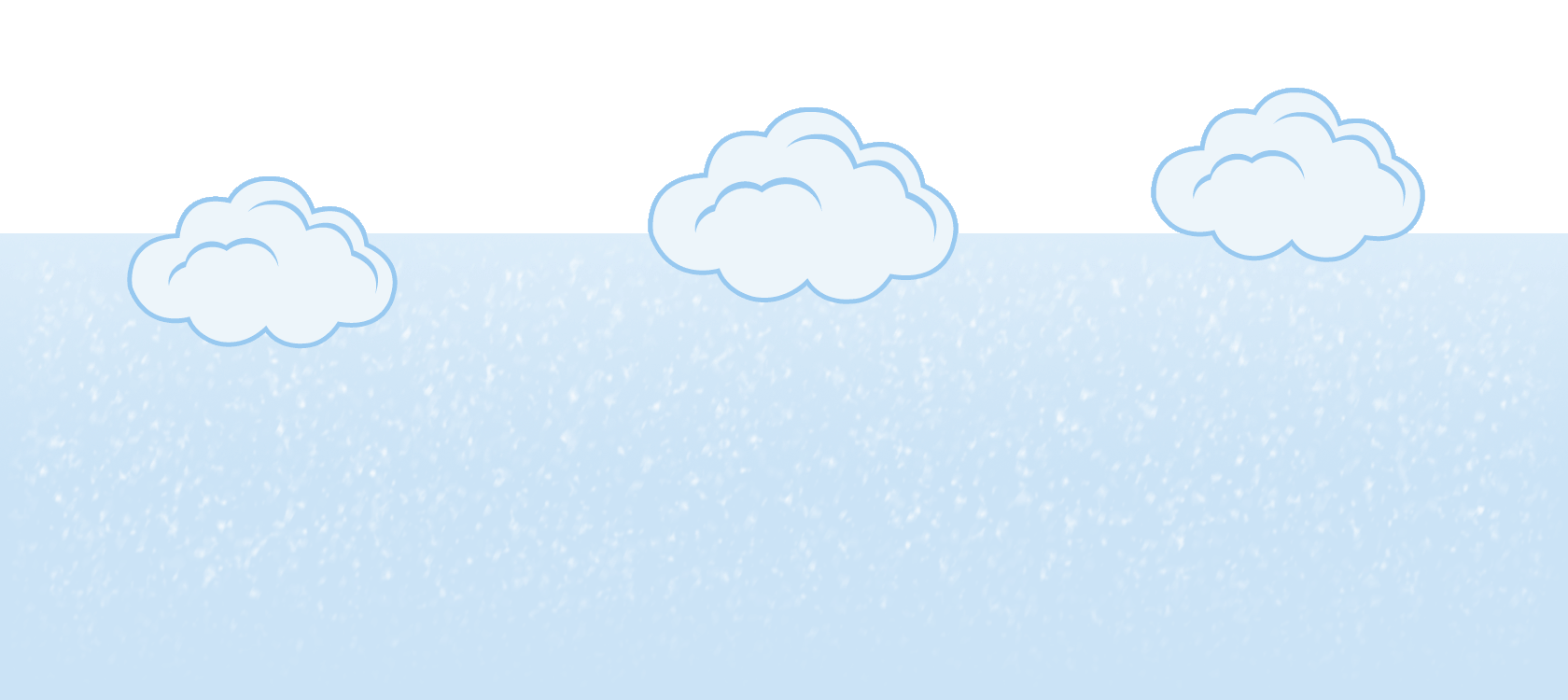
Sunset Tower in the Pacific Island Water Garden, Franklin Park Conservatory. Image courtesy of mwhaling, Flickr.
In this informational text, elementary students learn how plants are adapted for life in specific climates. The text takes them through the various rooms and displays at the Franklin Park Conservatory in Columbus, Ohio, to learn about plants from four biomes around the world. The text can be used in conjunction with the lessons featured in the articles Lessons About Organisms, Their Adaptations, and Their Environments and in the unit plans described in the article Unit Plans About Organisms, Their Adaptations, and Their Environments. The texts can also be used in conjunction with the lapbooking activity described in Lapbooks: Getting Creative With Science in the School Library.
Versions of this text are available at the K-2 and 3-5 grade bands. The Flesch-Kincaid reading level of each version is provided following the text. Each version is available as a text document, a full-color illustrated book (downloadable PDF documents) that you can print, copy, and use with your students, and an electronic version with recorded audio narration. The two reading levels can help you differentiate instruction for your students. You can use these various versions and formats as you differentiate instruction for your students.
GRADES K-2
Plants Need the Perfect Place
by Jessica Fries-Gaither
What do you do when it’s cold outside? Do you put on a sweater? Crawl under the blankets in your bed? Ask your parents to turn up the heat?
What do you do when it’s hot outside? Do you wear shorts and T-shirts? Eat cold popsicles? Ask your parents to turn on a fan?
People live in cold places. They make their houses warm. They wear warm clothes. People live in hot places. They make their houses cool. They wear light clothes. People can live almost anywhere!
Plants and animals can’t do many of these things. They can only live in certain types of places. They need to live in a place that is just right for them.
Let’s visit Franklin Park in Columbus, Ohio. You can see lots of plants there. Some of the plants grow in Ohio. Some plants are from other parts of the world. You can see them in a special building.
Let’s walk through the building. Each room looks and feels different. It shows a different part of the world. What kinds of plants live there?
One room is like the mountains. This room is cool. Plants that live here need cool temperatures.
The next room is like the rainforest. This room is hot and humid! Huge plants grow here. They need warm temperatures and lots of rain.
The plants in the desert room don’t need much water. It is dry here.
Giant ferns and palm trees grow in the last room. It is warm and humid here. The plants that grow here need a lot of water.
The plants that grow in the rooms can’t grow outside in Ohio. They need just the right amount of heat. They need just the right amount of water. The people who take care of them make sure they get what they need.
Animals have to live in certain places, too. Can you name some animals that live in cold places? How about hot places? Where could you go to learn more about animals and the places they live?
Flesch-Kincaid Reading Level = 1.4
Access this Grades K-2 text as a text-only document.
Access this Grades K-2 text as a full-color illustrated book.
Access this Grades K-2 text as an electronic book.
Notes for assembling the illustrated books:
You can put this book together a couple of different ways. You can print out the pages, cut them in half and then order the pages back to front. Fold the stack in half and then staple the spine of the book. Pairs of pages can then be stapled or glued along the right edge.
You can also assemble the book as a foldable book.
To assemble the books this way, print the four pages and align the document pages so that the following book page numbers are in the lower right-hand corner: front page, page 6, page 2, and page 4. (The cover page should be on top and page 4 on the bottom.) Set your copier to copy single pages into double pages and run the four document pages in the order specified. Cut along the dotted line in the center of the double-sided page, place the book pages in order, fold, and staple along the spine.
GRADES 3-5
Plants Need the Perfect Place
by Jessica Fries-Gaither
What do you do when it’s cold outside? Do you put on a sweater? Burrow under the blankets in your bed? Ask your parents to turn up the heat?
And what about when it’s hot? Maybe your parents turn on the air conditioning. You probably wear shorts and T-shirts instead of pants and long- sleeved shirts. You might go swimming or eat cold popsicles.
Heat and air conditioning help us when the weather is hot or cold. These are examples of technology. Technology is using science to make things that make our life better or easier. Technology helps us live in different environments. People that live in places that are cold need to heat their homes and buildings. People in hot places can use air conditioning to keep homes and buildings cool.
Our actions, or behaviors, also help us live in different kinds of environments. We might move into the shade to stay cool. We can put on extra clothes to stay warm.
Technology and behavior help people live in most places on Earth. Some people live on the cold Arctic tundra. Others live in hot and humid rainforests. Still others live in hot and dry deserts. And some of us live in places where temperatures aren’t as extreme. We can live almost anywhere!
It’s not that simple for plants and animals. Plants and animals are adapted to live in specific environments. They need certain temperatures to survive. Plants need the right amounts of rain and sunlight. Plants and animals can’t put on a sweater if it is too cold. They can’t go into an air-conditioned building if it is too hot. They depend on their environment to be just right for them.
You can learn more about plants and their needs by visiting a conservatory. This is a place where plants are grown and displayed. At the Franklin Park Conservatory in Columbus, Ohio, you can see over 400 plants from all over the world. Are you ready to take a little tour?
First, let’s walk through the Himalayan Mountain room. Plants that live in this environment are adapted to live in cool temperatures. They can grow in rocky soils and survive in strong winds. This room is kept cool, just like the plants’ natural environment.
Let’s leave the Himalayan Mountain room. As soon as you walk into the next room, you know where you are. It’s the tropical rainforest! The air is hot and humid and huge plants are growing everywhere. These plants need warmer temperatures and lots of rainfall to survive.
Walk through another door and into the desert! You notice that while it is still hot, it’s not humid. In fact, the air is dry. You see cacti and other plants that are well suited for life with extreme temperatures and little water.
Finally, a short walk takes you to the Pacific Islands room. Like the tropical rainforest, this room is warm and humid. Gigantic ferns grow here. So do palm trees and other plants that like rain and warm weather.
These plants can grow in the conservatory because the rooms are like their natural environments. The people who work there keep the rooms at the right temperature. They make sure the plants get the right amount of water. Without their care, the plants wouldn’t be able to live and grow in Ohio.
Now you know how plants are adapted to their environments. What about animals? What animals might live in each of these four environments? How would they be adapted to live there?
Glossary
adapted – a way that a living thing is suited for life in its natural environment
behaviors – actions of an animal in response to its environment
conservatory – a place where plants are grown and displayed
technology – using science to make things that make our life easier or better
Flesch-Kincaid Reading Level: 4.9
Access this Grades 3-5 text as a text-only document.
Access this Grades 3-5 text as a full-color illustrated book.
Access this Grades 3-5 text as an electronic book.
Notes for assembling the illustrated books:
You can put this book together a couple of different ways. You can print out the pages, cut them in half and then order the pages back to front. Fold the stack in half and then staple the spine of the book. Pairs of pages can then be stapled or glued along the right edge.
You can also assemble the book as a foldable book.
To assemble the books this way, print the four pages and align the document pages so that the following book page numbers are in the lower right-hand corner: front page, page 6, page 2, and page 4. (The cover page should be on top and page 4 on the bottom.) Set your copier to copy single pages into double pages and run the four document pages in the order specified. Cut along the dotted line in the center of the double-sided page, place the book pages in order, fold, and staple along the spine.
This article was written by Jessica Fries-Gaither. Jessica is an education resource specialist at The Ohio State University and project director of Beyond Penguins and Polar Bears. She has taught in elementary and middle school settings. Email Jessica at beyondweather@msteacher.org.
Copyright May 2011 – The Ohio State University. This material is based upon work supported by the National Science Foundation under Grant No. 1034922. Any opinions, findings, and conclusions or recommendations expressed in this material are those of the author(s) and do not necessarily reflect the views of the National Science Foundation. This work is licensed under an Attribution-ShareAlike 3.0 Unported Creative Commons license.



